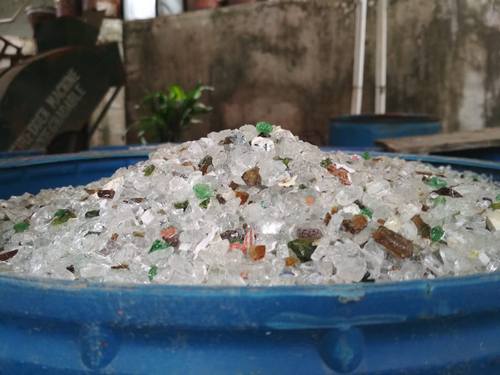
LIKE BAKING CUPCAKES. That’s how employees of Cebu City Hall’s City Environment and Natural Resources Office describe the process of converting glass shards into cement blocks.
Not everything that’s broken is meant to be thrown away.
Take for instance, glass shards and bottles collected from the 600 tons of garbage generated by Cebu City daily.
Even though they had broken into pieces, the glass materials are now being used to help protect the city’s riverbanks, and to keep the city’s parks clean and beautiful.
Since May, the Cebu City Environment and Natural Resources Office (CCENRO) started to recycle waste glass as an aggregate for concrete bricks.
CCENRO chief Ma. Nida Cabrera noted that discarded bottles and broken glass are among the largest types of waste collected by the Department of Public Services (DPS) from the city’s streets, households and commercial establishments.
The disposal of waste glass in landfills has become an important environmental challenge for CCENRO prompting Cabrera to find ways of recycling them into construction materials.
Last May, Cabrera launched a glass recycling program at a city-owned property in the North Reclamation Area (NRA), about 12 kilometers from the city’s landfill located in Barangay Inayawan.
At the recycling facility, the glass is milled or finely ground to replace part of the sand needed to produce the concrete blocks.
Repurposing the waste glass into a construction material reduces the use of the Inayawan landfill and the cost of garbage collection.
“The city collected around five to 10 tons of glass shards and bottles daily last year, and paid P20,000 (monthly) for the tipping fee,“ said Cabrera.
“This is why we’ve been looking for means to reduce the number of waste collected to also reduce the amount we pay for the tipping fee,” she further explained.
Under the recycling program, discarded glass collected from the city’s garbage are brought to the NRA in Barangay Mabolo where the city’s septage treatment plant (STP) is also located.
Right beside the STP is a small warehouse that houses two grinding machines used to crush glass into tiny pieces.
The plant at the NRA, run by five CCENRO workers, now produces an average of 100 concrete blocks per day.
According to 41-year-old Noel Grospe, one of the CCENRO employees manning the facility, creating the special bricks is similar to baking cupcakes.
These bricks made from glass shards will be used to create pathways along rivers in Cebu City.
The glass pieces Grospe collects from the grinding machine are placed in a basin and poured into a cement mixture.
The workers then mix the pulverized glass and the cement together with water until the desired consistency is achieved and the surface becomes smooth.
Sitting beside Grospe, at the time of the interview, was a pile of star-shaped moulders made of fiberglass.
“Once we start pouring the wet mixture into the moulder, we wait for eight hours until they harden. Usually, we start working at around 7 a.m. so that our work is done by 3 p.m.,” explained Grospe in Cebuano.
The following day, the finished products are tested for strength either by stepping or jumping on them, he added.
“Everytime they don’t crack or break into pieces, we feel a little joy not only because we accomplished our work but who would have thought that they were made out of glass bottles that were collected from trash,” Grospe added.
The concrete blocks made with pulverized glass will be placed on the banks of Butuanon River and Mahiga Creek to prevent the soil from eroding and will be used to create a pathway near the river.
Based on research, mixing ground waste glass into the cement makes the concrete stronger, more durable and more resistant to water.
The special bricks will also soon find their way into the city’s parks.